Technology preparation for the L2 mission: Athena
Athena is a next-generation X-ray space observatory designed to study the hot, million-degree Universe (e.g. supermassive black holes, evolution of galaxies and large-scale structures, and matter under extreme conditions).
Athena will offer spatially-resolved X-ray spectroscopy and deep wide-field X-ray spectral imaging with performance greatly exceeding that offered by current X-ray observatories. It will open the door to new scientific observations requiring high spectral resolution (2.5 eV) imaging with large area and low background. Its instrumentation will consist of a Wide Field Imager (WFI) and a cryogenic X-ray spectrometer called the X-ray Integral Field Unit (X-IFU).
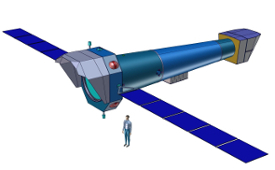 |
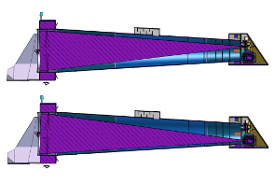 |
| Left: The Athena spacecraft (Phase 0 design): a 12-m telescope with the Mirror Assembly Module containing the Silicon Pore Optics (SPO) Mirror Modules and the Science Instrument Module containing the instrumentation. Right: The complete mirror is shared between two instruments with the help of a mechanism. Credit: ESA Concurrent Design Facility | |
The technology development activities for this mission are focussed on the critical elements that are either completely novel or have never been applied in a similar application or environment. These elements will need to have achieved a Technology Readiness Level (TRL) of 5/6 at the time of mission adoption.
For Athena, these activities are mainly focussed on the development of the X-ray optics and the required cryogenic chain for X-IFU. In addition, there are also a number of bespoke spacecraft technologies that also need dedicated activities to increase their TRL.
X-ray optics
Athena will solve the existing mass-area-resolution challenge by using novel telescope optics to focus X-ray photons onto the focal plane instrumentation based on Silicon Pore Optics (SPO). SPO are an enabling technology conceived in 2001 and currently being developed to TRL 5.
SPO utilise commercially available Si wafers which have surface figure and roughness quality ideally suited to X-ray optics applications. An SPO module comprises two wafer stacks integrated together. The first stack is a set of concentric and confocal mirror plates that approximate the paraboloid surfaces (1st reflection) in a nested Wolter I system and the second stack provides an approximation to the hyperboloid (2nd reflection) in the nested Wolter I system. Each module acts as an individual lenslet. The full mirror can be populated by arranging the modules in rings.
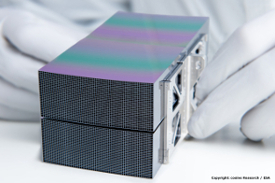 |
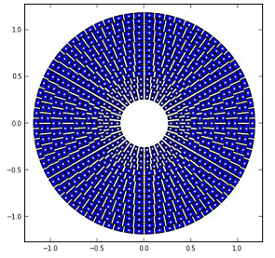 |
| Above: A Silicon Pore Optics (SPO) Module; Right: A schematic of a mirror aperture with hundreds of SPO Modules placed at different rows. Credit: ESA |
As an example, in order to support the required X-ray optics of the mission, the technology development activities focus on the:
- SPO Module maturation and environmental testing,
- development of mass production processes,
- development of coating and coating facilities,
- design and development of the Additive Layer Manufacturing (ALM) Mirror Structure to which the SPO Modules are mounted,
- integration and alignment of SPO Modules into the mirror structure,
- modelling and testing of proton transmission through the mirror.
Cryogenic chain
The X-IFU instrument on Athena is based on a large array of Transition Edge Sensors (TES) that need to be kept cool by a cryogenic bath of 0.5 mK. This requirement drives the need for a complex cryogenic chain involving a combination of an Adiabatic Demagnetization Refrigerator (ADR), Joule Thompson coolers, and Pulse Tube coolers. More information about the cryogenic chain can be found here.
The operation of X-IFU is very sensitive to electromagnetic interference and micro-vibrations which leads to the need to have dedicated technology development activities to:
- develop demonstrators of Pulse Tube and Joule Thomson coolers,
- develop a demonstrator of the cryogenic harness,
- develop a demonstrator of cryogenic micro-vibration dampers,
- design and develop a demonstrator of the complete Detector Cooling System (DCS) representative of the mission configuration.
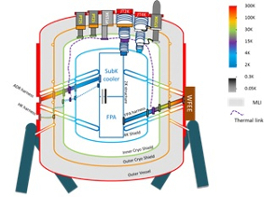 |
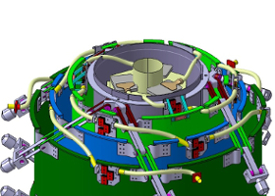 |
| Representation of the cryogenic chain on the Detector Cooling System activity. Credit: ESA | View on the cryostat assembly (dewar) including cryogenic harness, structural mounts and temperature shields. Credit: CNES, INTA |
Other critical elements
Additionally, the Athena spacecraft will rely on the development of a number of bespoke technologies to support both the operation of the spacecraft and the instruments.
For example, development activities are also required for:
- design and development of a demonstrator for the Instrument Switching Mechanism (ISM), allowing to tilt the mirror from one instrument to another,
- design and development of a demonstrator of a charged particle magnetic diverter system,
- design and development of a demonstrator of a Hold Down and Release Actuator with high load and low shock.
More details on the activities can be found within the Science Programme Technology Development Plan.
